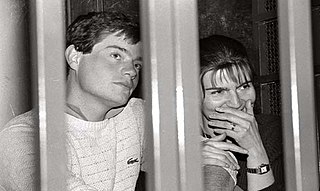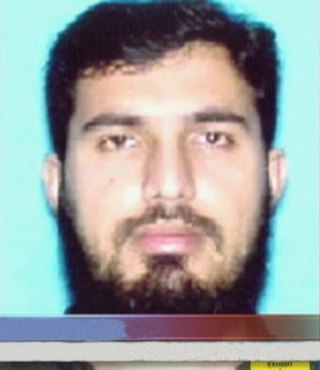Related Research Articles

Armenian Secret Army for the Liberation of Armenia (ASALA) was a militant organization active between 1975 and the 1990s whose stated goal was "to compel the Turkish Government to acknowledge publicly its responsibility for the Armenian genocide in 1915, pay reparations, and cede territory for an Armenian homeland." ASALA itself and other sources described it as a guerilla and armed organization. Some sources, including the United States Department of State, as well as the Ministry of Foreign Affairs of Azerbaijan listed it as a terrorist organization.
Justice Commandos of the Armenian Genocide (JCAG) was an Armenian militant organization active from 1975 to 1987.

Terrorism in Saudi Arabia has mainly been attributed to Islamic extremists. Their targets included foreign civilians—Westerners affiliated with its oil-based economy—as well as Saudi Arabian civilians and security forces. Anti-Western attacks have occurred in Saudi Arabia dating back to 1995. Saudi Arabia itself has been accused of funding terrorism in other countries, including Syria.
The 2004 financial buildings plot was a plan led by Dhiren Barot to attack a number of targets in the U.S. and the United Kingdom which is believed to have been approved by al-Qaeda. The evidence against the plotters consisted of home videos, written notes, and files on computers. At the time of the arrests the group had no funding, vehicles, or access to bomb-making equipment.
Revolutionary Struggle is a Greek anarchist, anti-imperialist, urban guerrilla group known for its attacks on Greek government buildings and the American embassy in Athens. It is designated as a terrorist group by the Greek government, the European Union (EU), and the United States.
Mohammad Momin Khawaja is a Canadian found guilty of involvement in a plot to plant fertilizer bombs in the United Kingdom; while working as a software engineer under contract to the Foreign Affairs department in 2004 became the first person charged and found guilty under the Canadian Anti-Terrorism Act following the proof that he communicated with British Islamists plotting a bomb attack. On March 12, 2009, Khawaja was sentenced to 10.5 years in prison and was eligible for parole five years into the prison term. On December 17, 2010, Khawaja's sentence was increased to life imprisonment by the Ontario Court of Appeals.

Giuseppe Valerio Fioravanti is an Italian former terrorist and actor, who with Francesca Mambro, was a leading figure in a far-right terrorist group, Nuclei Armati Rivoluzionari. Fioravanti appeared in films and television from a young age, and in his early teens was the most famous child in Italy. He and Mambro were fugitives wanted for terrorist offences by their early twenties, they spent a further period on the run as suspects in the Bologna bombing. Both were captured after gunfights with police, and later found guilty of responsibility for the Bologna train bombing; they were sentenced to ten life terms, plus 250 years. Fioravanti was released from prison in 2009.
The Melbourne Turkish consulate bombing was an attempt to bomb the Turkish Consulate in Melbourne, Victoria, Australia, on 23 November 1986. A car bomb exploded in the basement car park, killing Hagop Levonian, one of the bombers, who was a member of the Armenian Revolutionary Federation (ARF).
Andrew Philip Michael Ibrahim is a British Muslim convert, also known as Isa Ibrahim after his conversion to Islam. Ibrahim was arrested by the Avon and Somerset Police on suspicion of terrorism, and on 17 July 2009 convicted of preparing terrorist acts.

In the United States, a common definition of terrorism is the systematic or threatened use of violence in order to create a general climate of fear to intimidate a population or government and thereby effect political, religious, or ideological change. This article serves as a list and a compilation of acts of terrorism, attempts to commit acts of terrorism, and other such items which pertain to terrorist activities which are engaged in by non-state actors or spies who are acting in the interests of state actors or persons who are acting without the approval of foreign governments within the domestic borders of the United States.
The Orly Airport attack was the 15 July 1983 bombing of a Turkish Airlines check-in counter at Orly Airport in Paris, by the Armenian militant organization ASALA as part of its campaign for the recognition of and reparations for the Armenian genocide. The explosion killed eight people and injured 55.
The 1983 Turkish embassy attack was an attack on the Turkish embassy in Lisbon on 27 July 1983, which resulted in the death of 7 people, including all 5 attackers.
The Turkish consulate attack was an attack on the Turkish consulate in Paris, France, on 24–25 September 1981. According to a statement issued by Armenian Secret Army for the Liberation of Armenia, army's militants demanded to release political prisoners in Turkey including two Armenian clergymen Father Manuel Yergatian and Pastor Hrant Guzelian and 10 non-Armenians.

Najibullah Zazi is an Afghan-American who was arrested in September 2009 as part of the 2009 U.S. al Qaeda group accused of planning suicide bombings on the New York City Subway system, and who pleaded guilty as have two other defendants. U.S. prosecutors said Saleh al-Somali, al-Qaeda's head of external operations, and Rashid Rauf, an al-Qaeda operative, ordered the attack. Both were later killed in drone attacks.
Failed terrorism plots are terrorist plots that have either been foiled, uncovered by authorities or failed through mistakes.

Naser Jason Abdo is an American former United States Army private first class who was arrested in 2011 for attempting to commit a terrorist attack against a restaurant frequented by soldiers from Fort Hood, Texas. He was convicted in federal court and sentenced to two consecutive life terms, plus 60 years, which he is currently serving in ADX Florence.
Definition of terrorism in Turkey is categorized under Turkey's criminal law as crimes against the constitutional order and internal and external security of the state by the use of violence as incitement or systematic to create a general climate of fear and intimidation of the population and thereby effect political, religious, or ideological goals. Since the establishment of the Republic of Turkey, both organized groups, lone wolf, and international spy agencies have committed many acts of domestic terrorism against Turkish people.
Terrorism in Switzerland has occurred periodically since the 1970s. Switzerland has experienced both domestic and international terrorism over the past several decades, though domestic terrorism was primarily low‐level violence.
References
- ↑ "US ACCUSES PRO-ARMENIA GROUP'S CHIEF OF BOMB PLOT". Chicago Tribune. Associated Press. October 16, 1999. p. 13.
- 1 2 "Terrorism 2000/2001". Federal Bureau of Investigation. Archived from the original on September 15, 2004.
- 1 2 3 ( Walton 2006 , p. 342)
- ↑ Kushner, Harvey W. (2002). Encyclopedia of Terrorism. SAGE. p. 86. ISBN 978-0-7619-2408-1.
- 1 2 3 4 5 6 "US accuses pro-Armenia group's chief of bomb plot". Chicago Tribune. Associated Press. October 16, 1999. p. 13.
- ↑ "Statement of the Armenian National Committee of America". ARF News. October 19, 1999. Archived from the original on June 12, 2008. Retrieved May 27, 2009.
- 1 2 3 4 5 6 7 8 Kaplan, David E. (January 28, 2001). "Following Terror's Forgotten Trail. An explosives case raises ghosts of a bloody past". U.S. News & World Report. Archived from the original on February 1, 2011. Retrieved September 5, 2017.
- 1 2 3 4 "The Filthiest 48 Hours". LA Weekly. Archived from the original on May 25, 2011.
- ↑ Melton, Terry (2009). "Mitochondrial DNA Examination of Cold Case Crime Scene Hairs". Forensic Magazine. No. April/May 2009. Archived from the original on June 3, 2009. Retrieved June 7, 2009.
- ↑ Gunter, Michael M. (1986). "Pursuing the Just Cause of their People": A Study of Contemporary Armenian Terrorism. Westport-New York-London: Greenwood Press. pp. 43–44. ISBN 9780313252471.
- ↑ Hyland, Francis P. (1991). Armenian Terrorism: The Past, the Present, the Prospects. Boulder-Jerusalem: Westview Press. ISBN 9780813381244.
- ↑ Simsir, Bilâl (2000). "Sehit Diplomatarimiz". Ankara: Bilgi Yayinevi.
- 1 2 3 4 5 Ellement, John (October 16, 1999). "Armenian-American site in Franklin named Camp was allegedly used for terrorist training". The Boston Globe.
- ↑ "Activist charged with being head of bomb group". News & Observer. Raleigh, North Carolina. October 16, 1999. p. A.8.
- ↑ "Armenian Terrorism: The Case of Mourad Topallian and the JCAG Terror Group". Assembly of Turkish American Associations. Archived from the original on August 10, 2015.
- ↑ Hagan, John F. (May 12, 2000). "Former CCC vice president admits to storing explosives". The Plain Dealer. Cleveland, Ohio. p. 1.A.